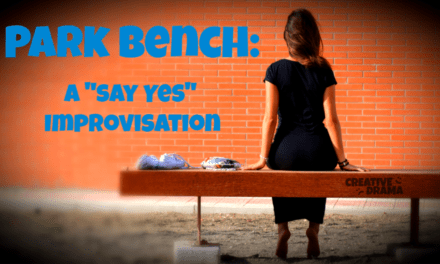Participants pantomime objects or ideas to each other in a no-words variant of “Whisper Down the Lane,” so that the last person in the line has the same “message” as the first.
Game Type: Skills Development
Age Range: 10+
Number of Participants: 4-10 participants per line
Materials: Cards with the items to be pantomimed written on them.
Directions:
- Make sure the participants understand the basic concept of pantomime – there is no talking, mouthing of words, or using actual objects during the game.
- Demonstrate two different ways someone might pantomime the idea of a jack-in-the-box:
- Be a person holding and winding up the jack-in-the-box, surprised when it “pops”, pushing the “jack” back down and closing the lid;
- be the “jack” pushed down into the box, vibrating as the handle is turned, springing up at a random time.
- Divide participants into groups of four to ten people so that no one is waiting “too long” for a turn (shorter for younger students).
- Each group sits or stands in a straight well-spaced line, facing “backward” except for the first person.
- Remind participants that they are not allowed to talk at any point in the game.
- The first person in each line is given a card with an object to mime listed on it (see list below), reads it, and returns the card.
- The first person then turns around (he is now facing the same direction as the rest of the line).
- The first person turns taps the second person in line on the shoulder so that she turns to face him.
- The first person mimes the object, and keeps doing so until…
- …The second person thinks she knows what the object is, and nods.
- The second person then turns and taps the third person in line on the shoulder.
- He turns around, and the second person mimes that object. When he knows what the object is, he nods.
- Then the third person repeats the process, and the object is mimed in this fashion down the line to the last person.
- The objective of the game is that pantomime of the object is clear enough each time so that it stays the same object all the way down the line.
- Usually, the object changes into something entirely different – the interesting thing is to see how it changed along the line.
- Each person should tell the rest of the line what she thought the object was, and discuss what she saw her partner demonstrating.
Variations: There are many variations that can be played with this game, by changing the object to a movie or book title, or incorporating concepts from a curricular area into the game. For example, the pantomime could be of a part of speech (preposition) or a science concept (gravity).
Tips:
The game requires a lot of silence and patience from participants; keep your students’ limits in mind when dividing a class into groups.
Make sure the objects are ones that the participants are likely to have used or seen used often enough that they don’t get stuck trying to figure out how the thing works. For example, a photocopier is near and dear to the hearts of teachers, but kids don’t have many opportunities to use them.
Here’s some objects that upper elementary and middle school kids have had fun pantomiming –
Toaster
Computer
Blender
Washing machine
Camera
Bicycle
Merry-go-Round
Train
Garbage Truck









